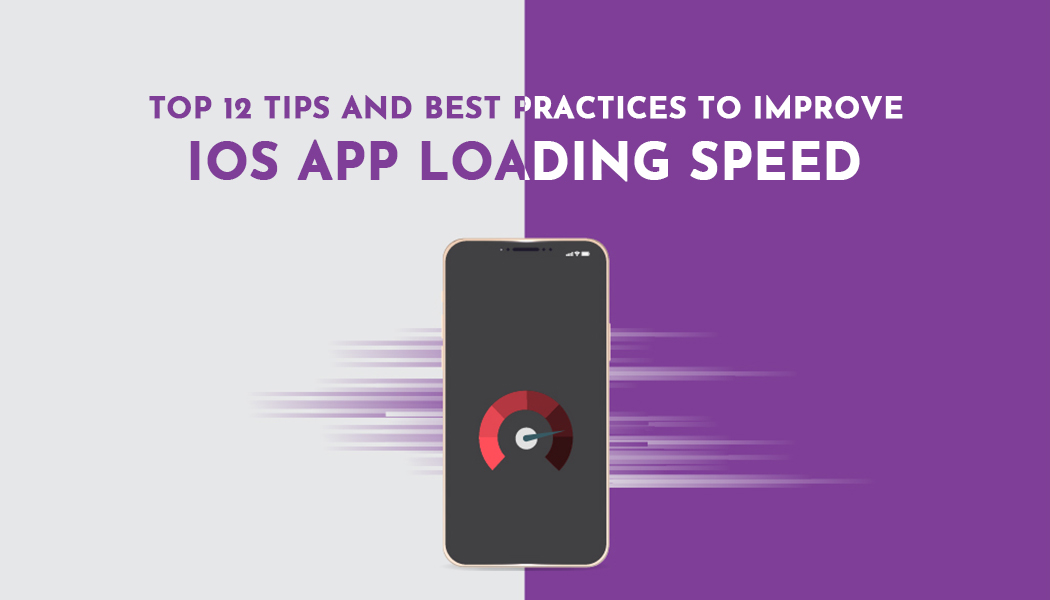Top 12 Tips and Best Practices to Improve iOS App Loading Speed
Are you tired of waiting for your favorite iOS apps to load? Is the sluggish loading speed of your iPhoneapplications driving you crazy? If so, you've arrived at the best place! To improve the sluggishness of theiOS app, you will have to do the proper iOS app optimization. But for that, you will need the best iOS tipsand tricks you will be getting from here, and you will need the best iOS app development company toresolve all the complex issues.
So, in this blog, you will get everything you need to know about improving iOS app loading speed. In theend, if you do iOS app performance testing, you will notice an improvement in iOS app loading speed.
Top 12 Best Tips and Best Practices to Boost iOS App Loading Speed
Users who download or open an app expect it to load quickly and be responsive. App loading speed directly impacts user satisfaction and engagement. Studies have shown that users are more likely to abandon an app if it takes too long to load. Therefore, optimizing your iOS app's loading speed is vital for retaining users and achieving success in the highly competitive app market. Here are iOS Tips and Tricks with best practices you should know.
1. Minimize App Size with iOS App Optimization
One of the critical factors affecting app loading speed is its size. Larger apps take longer to download and install, leading to slower loading times. To minimize app size, consider the following techniques:
- Remove unused resources, such as images, sounds, or files.
- Optimize app assets by compressing images and videos without sacrificing quality.
- Use asset catalogs to manage image resources efficiently.
- Take advantage of on-demand resources to load content dynamically.
- If it's a complex problem, the iOS App Development Company can help.
2. Optimize Images and Graphics
It's one of the best iOS Tips and Tricks. Images and graphics can significantly impact app loading speed. To optimize them:
- Use the appropriate image format (JPEG, PNG, or HEIC) based on the content and quality requirements.
- Employ lossless or lossy compression methods to reduce image file sizes.
- Utilize image asset slicing to load only the necessary portions of an image.
3. iOS App Optimization by Compressing and Caching Data
Data compression and caching techniques can enhance app loading speed by reducing the amount of data that needs to be transferred over the network. Consider the following practices:
- Enable gzip or brotli compression on your server to compress network responses.
- Implement data caching to store frequently accessed data locally, reducing network requests.
4. Use Asynchronous Operations
Asynchronous operations also come under one of the best iOS Tips and Tricks. Executing time- consuming processes synchronously can lead to slow loading speeds. Instead, leverage asynchronous programming techniques that the best iOS App Development Company uses:
- Perform network requests, file I/O, and heavy computations asynchronously to avoid blocking the main thread.
- Use Grand Central Dispatch (GCD) or Operation Queues to manage concurrent tasks effectively.
5. iOS App Optimization by Prioritizing Critical Content
Load critical content first to give users the perception of a faster app loading experience. Follow these steps:
- Identify the essential elements required for the initial screen.
- Load these elements first, such as the main interface, navigation controls, or primary data.
- Load non-essential elements in the background to prevent delays in the user interface.
6. Lazy Loading of Resources
Lazy loading is a technique that comes under the best iOS Tips and Tricks that loads resources only when needed rather than loading them all upfront. This approach can significantly improve loading speed. Consider the following:
- Load images, videos, or additional content as users scroll or interact with the app
- Implement pagination or infinite scrolling to load data gradually
- If any other complex resources need attention, it can only be done by an expert iOS App Development Company
7. Minimize Network Requests
Excessive network requests can slow down the app's loading speed. Optimize network communications with these tips:
- Group several requests into a single request whenever possible
- Reduce unnecessary API calls and optimize data synchronization
- Utilize WebSocket or other real-time communication protocols for live data updates
8. iOS App Optimization by Improving Database Queries
If your app uses a database, inefficient queries can hinder loading speed. You can also know it by iOS app performance testing. Improve database performance by:
- Indexing frequently accessed fields for faster data retrieval.
- Optimizing complex queries and joins to minimize execution time.
- Implementing database caching mechanisms to reduce query frequency.
9. Reduce External Dependencies
It's one of the standard iOS Tips and Tricks most iOS App Development Companies use. Excessive external dependencies like third-party libraries or frameworks can impact app loading speed. Mitigate this by:
- Evaluate the necessity of each dependency and remove any unused or redundant ones.
- Replace heavy dependencies with lightweight alternatives where possible.
- Keep dependencies updated to leverage performance improvements and bug fixes.
10. iOS App Optimization by Employing CDNs
Content Delivery Networks (CDNs) can distribute app resources across multiple servers globally, improving loading speed for users in different regions. Consider the following:
- Host static assets, such as images or videos, on a CDN
- Leverage CDNs to deliver dynamic content efficiently, such as JSON data or API responses.
11. Implement App Slicing
App Slicing is an iOS feature that allows the App Store to deliver only the necessary app assets for a specific device. To enable App Slicing:
- Use asset catalogs to manage image resources for different device resolutions.
- Remove unnecessary device-specific resources from the app bundle.
12. iOS App Optimization by Regularly Updating and Maintaining the App
Regularly updating and maintaining your app is essential for improving its loading speed. That's why
most businesses partner with iOS App Development Companies. Stay up to date with the latest iOS
versions and incorporate performance optimizations introduced by Apple. Its common iOS Tips and
Tricks promptly address user feedback and bug reports to fix loading speed issues.
Also, optimize resource management and memory usage to prevent performance degradation over
time, continuously monitor and analyze loading speed metrics, and do iOS app performance testing to
identify areas for improvement.
Final Snippets
In today's competitive app market, optimizing iOS app loading speed is vital for user satisfaction and engagement. Implementing these tips and best practices discussed in this blog ensures that your app delivers a seamless and fast user experience.
Remember to regularly update and maintain your app while monitoring performance metrics to stay ahead of the competition, including iOS app performance testing. Also, sometimes projects require high standards of knowledge and experience to resolve issues, add new and complex features, and fix compatibility scenarios. In that matter, one can get help from iOS App Development Company.
FAQs (Frequently Asked Questions)
How do I optimize my iOS apps?
To optimize your iOS apps:
- Optimize your code by identifying and fixing performance bottlenecks, reducing memory usage, and implementing efficient algorithms.
- Use proper image compression techniques, minimize network requests, and cache data to improve app loading speed and reduce data usage.
- Test your app thoroughly, gather user feedback, and make iterative improvements based on analytics to enhance user experience and overall app performance.
What is iOS app thinning?
iOS app thinning is a method to decrease the size of iOS apps by removing unnecessary code and resources during installation. It involves app slicing, on-demand resources, and bitcode, reducing download size, optimizing storage, and enhancing performance.
How do I reduce and optimize iOS app size?
To reduce and optimize your iOS app size:
- Compress and optimize images.
- Remove unused code and resources.
- Utilize app thinning techniques.
- Minimize external libraries and frameworks.
- Optimize asset sizes.
- Use asset catalogs.
- Consider dynamic frameworks.
- Optimize code and memory usage.
- Test for compatibility and performance.
Does app loading speed affect user retention?
Yes, slow loading speeds can significantly impact user retention, as users are likelier to abandon an app that takes too long to load.
Are there any tools to measure app loading speed?
Yes, you can use tools like Xcode Instruments and performance monitoring tools provided by Apple to measure and analyze app loading speed.
What is lazy loading, and how does it improve loading speed?
Lazy loading is a technique that loads resources only when needed, reducing the initial loading time and improving the overall app loading speed.
How can I optimize database queries for better loading speed?
You can optimize database queries by indexing frequently accessed fields, optimizing complex queries and joins, and implementing database caching mechanisms.
Is it essential to test app loading speed on real devices?
Testing app loading speed on real devices is crucial as emulators or simulators may not accurately reflect the loading experience on actual devices.




